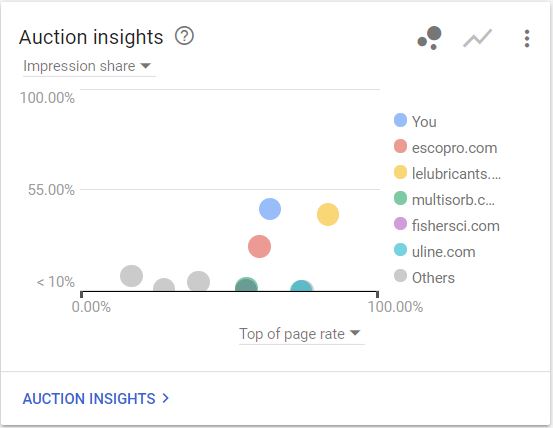Benchmarking
Now that you have set up your campaign and it has been running for a while, it is very helpful to see who you are competing with. You may be surprised to see not just the usual suspects, but competitors from adjacent or lateral verticals. The goal of this exercise is two-fold:
- Determine your relative standing and figure out what tweaks you need to make to your bidding strategy (or bids in case of manual bidding), and
- Tweak your ad strategy (ad groups and ad copy) based on who you are competing with
To illustrate this, I will use actual data from a client that sells filtration products and solutions. This campaign is for an industrial product, a desiccant breather. On the Campaign Overview page, look at the Auction Insights chart.

Competitive Metrics
The default metrics used for the two axes are Impression Share and Top of Page Rate. However, you could pick any of the following five available metrics from the drop-down to get a different view:
- Impression Share” is the number of impressions you received divided by the estimated number of impressions you were eligible to receive.
- “Outranking Share” is how often your ad ranked higher in the auction than another advertiser’s ad, or if your ad showed when theirs did not.
- “Overlap Rate” is how often another advertiser’s ad received an impression in the same auction that your ad also received an impression.
- “Top of Page Rate” is how often your ad (or the ad of another advertiser, depending on which row you’re viewing) was shown at the top of the page in search results.
- “Position Above Rate” is how often another advertiser’s ad in the same auction shows in a higher position than your own, when both of your ads were shown at the same time.
Click on the chart to get detailed data like this:

Assessment
The first thing I notice is that not only am I competing with Escopro and LELubricants, who are direct competitors that make desiccant breathers, but I am also competing with Amazon, Grainger, and ULine, probably for desiccants. I also see Fisher Scientific, a heavyweight with a broad product range. Finally, I see MultiSorb, ForFluids and AGMContainer, who all play in the desiccant or desiccant breather space, with AGM offering moisture control solutions. I can now sort my competition in three buckets:
- Direct competitors who sell the same product (Escopro, LELubricants, ForFluids and AGM Container)
- Adjacent Competitors who sell related product lines but with whom I do not compete directly (MultiSorb), and
- Broad Line competition (Amazon, Grainger, and ULine) who sell everything
At this point, I want to make sure that the Overlap Rate is low for the Broad Line competitors and Adjacent competitors, which it is. The overlap rate is highest for the two competitors I expect to compete head-on with. If this were not true, it would be a signal for me to review the ads and ad copy, making sure they clearly convey what my client sells, to whom, and what benefits the products provide. This is also an opportunity to review your keywords and tighten the funnel if needed by using broad match modifier or phrase match keywords.
I also notice that I have the highest impression share, which I like. I am pleased with my Top of Page Rate. However, I notice that LELubricants has a Position Above rate of 92%. Given that our Impression Shares are roughly the same, this means that they are bidding higher than me for the top spot. I now have a decision to make- given my budget, and the fact that I have a healthy Top of Page Rate, do I want to increase bids for this campaign or change my automated bid strategy? I choose not to, given my budget and the business results I am seeing.
To evaluate how you are doing when you go toe-to-toe with a competitor, look at Outranking Share. In this case, I would like to have a higher Outranking Share than LELubricants, but again, I am not willing to spend more given my Top of Page Rate.
Additional Insights
You can conduct this exercise not just at the campaign level, but also at the ad group and keyword level. You can also segment the Auction Insights report by time and by device to figure out trends and spot opportunities.